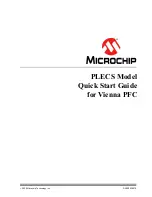24.4.9 Margin Read Commands
The Read-1s commands (Read 1s All Blocks and Read 1s Section) and the Program
Check command have a margin choice parameter that allows the user to apply non-
standard read reference levels to the program flash array reads performed by these
commands. Using the preset 'user' and 'factory' margin levels, these commands perform
their associated read operations at tighter tolerances than a 'normal' read. These non-
standard read levels are applied only during the command execution. All simple
(uncommanded) flash array reads to the MCU always use the standard, un-margined, read
reference level.
Only the 'normal' read level should be employed during normal flash usage. The non-
standard, 'user' and 'factory' margin levels should be employed only in special cases.
They can be used during special diagnostic routines to gain confidence that the device is
not suffering from the end-of-life data loss customary of flash memory devices.
Erased ('1') and programmed ('0') bit states can degrade due to elapsed time and data
cycling (number of times a bit is erased and re-programmed). The lifetime of the erased
states is relative to the last erase operation. The lifetime of the programmed states is
measured from the last program time.
The 'user' and 'factory' levels become, in effect, a minimum safety margin; i.e. if the reads
pass at the tighter tolerances of the 'user' and 'factory' margins, then the 'normal' reads
have at least this much safety margin before they experience data loss.
The 'user' margin is a small delta to the normal read reference level. 'User' margin levels
can be employed to check that flash memory contents have adequate margin for normal
level read operations. If unexpected read results are encountered when checking flash
memory contents at the 'user' margin levels, loss of information might soon occur during
'normal' readout.
The 'factory' margin is a bigger deviation from the norm, a more stringent read criteria
that should only be attempted immediately (or very soon) after completion of an erase or
program command, early in the cycling life. 'Factory' margin levels can be used to check
that flash memory contents have adequate margin for long-term data retention at the
normal level setting. If unexpected results are encountered when checking flash memory
contents at 'factory' margin levels, the flash memory contents should be erased and
reprogrammed.
CAUTION
Factory margin levels must only be used during verify of the
initial factory programming.
Functional Description
KL02 Sub-Family Reference Manual, Rev. 2.1, July 2013
322
Freescale Semiconductor, Inc.


















